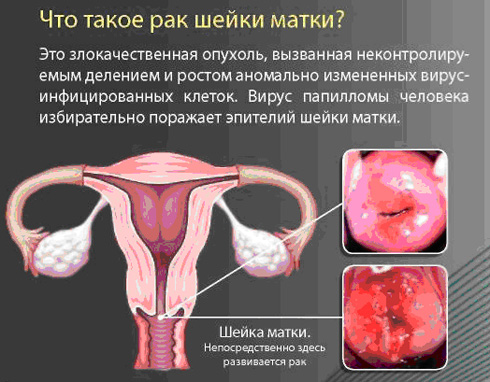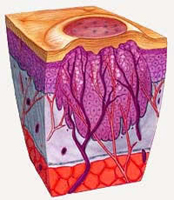Scary diagnosis - cervical cancer (RSM) - today is one of the most common among oncological diseases. Every day the cervical cancer takes the lives of 17 women in Russia.In Europe, a woman is dying every 15 minutes from cervical cancer.
Content
Why cervical cancer occurs?
This disease is not inherited, OO is caused by special types of human papilloma virus (HPV), infection that can occur during life. There are more than 100 types of HPV, but only 15 of them are oncogenic and cause
cervical cancer (RSM). The most dangerous and common among them 16, 18, 31 and 33 types of virus.
The peak of the incidence of cervical cancer falls at age from 45 to 65 years, but in recent yearsLabor is increasingly found in young women in WHOgrow from 18 to 29 years.
— Over 500,000 women in the world are sick of RSM per year — One woman every two minutes.
— Russia annually registers 13,000 cases of disease — 36 women per day.

How is HPV infection?
HPV is striking all — both men and women, and spreads very easily. To transfer it enough genital contact.
Remember — Condoms do not protect against HPV, as the virus is so small, which can penetrate through the pores of the condom. The presence of a virus in the body proceeds asymptomatic, most people do not suspect that they are infected with them.
The infection of the human papilloma virus does not always lead to cancer, in 50% of cases the body struggles independently with the virus, thanks to the immune protection and absence of concomitant diseases.
It is proved that 80% of women suffering from thrush are subject to HPV infection.
Factors provoking the emergence of cervical cancer:
- Long-term endometriosis, as well as erosion, dysplasia and leukoplakia cervix
- early start of sex life
- Frequent change of sexual partners
- The simultaneous presence of several sexual partners in both men and women
- Failure to comply with the rules of personal hygiene smoking and alcohol abuse
- immunodeficiency states deficiency in food vitamins, and with
How RSM is developing?
Aggressive Types of HPV affect the cells of the cervical mucosa and stimulate the synthesis of virus onco-proteins E6 and E7. Normally, these proteins are not synthesized. They suppress local and general immunity, cause the transformation of the virusified cells of the mucosa of the uterine cervical into atypical. If these cells do not detect on time, and do not stop the process of their rebirth, the cervical cancer can develop.
It is important to remember that the detection of infection of oncogenous HPV — this is not a diagnosis «crayfish». The process of cancer development more often lasts for several years, passing through a number of consecutive stages called «Prerostrate states», But sometimes it can develop in less than a year. Therefore, it is very important to reveal them in a timely manner and heal.
Do I have cervical cancer?
You can answer this question only after the examination of the gynecologist. During inspection, the doctor necessarily takes a stroke for a cytological research (research for changes in the cervix cells). Cervical cancer is a rare malignant tumor, the development of which can be prevented, because in most cases it develops against the background of long-term predrade diseases.
It is important to remember that the early stages of the disease do not show themselves, the symptoms arise when the disease is already reaching late stages. In Russia, more than 45% of cases of cervical cancer are detected already in the later, launched stages when surgical treatment is required.
How does the cervical cancer manifest?
In progression of the disease, abundant watery or bleeding from the vagina can appear, which, as a rule, appear after sexual intercourse, lifting gravity between menstruation, after the established menopause. In later stages, weakness appears, pain at the bottom of the abdomen, impaired urination.
How to protect yourself from cervical cancer?
The main way of preventing this formidable disease is inspections from an obstetrician-gynecologist with the obligatory taking of smears for cytological research on tumor cells, starting from 20 years or the start of sexual life and at least 1 time
in year. If you find HPV any type, then the inspection must be carried out 1 time in half a year.
Remember, if you regularly pass the examinations from the gynecologist, in most cases you can diagnose the disease and start the treatment still at the prejudice stage.
Prevention of cervical cancer.
Currently, 2 vaccines exist to protect against cervical cancer. Vaccines are designed for girls — adolescents from 9 to 17 years and young women from 18 to 26 years not infected with the virus.
Vaccines do not defend if the woman is already infected with HPV.
It's important to know!
Russian scientific scientists of molecular medicine MMA name and. M. Sechenov developed a unique, fundamentally new means for the prevention of cervical cancer — Promisan.
Promisan — non-neurmonal tool of natural origin, has a multiple counter¬tumor activity does not affect health¬Organs and fabrics.
Promisan is used in complex therapy with immo-solid drugs under cervical in-trapithelial neoplasia (CIN), for the prevention of relapses after the surgical interventions on the cervix (conization, excision, diathermocoagulation, etc.).
How Promiscian works?
- Causes the death of virus-infected cells
- Blocks the production of onkobelkov E6 and E7
- Restores antitumor protection of the body
Preparations can be purchased in the pharmacies of your city










